Dakor
Dankpur | |
|---|---|
city | |
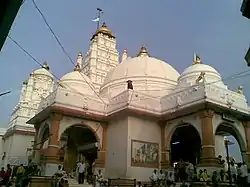 Ranchhodji Temple, Dakor | |
| Coordinates: 22°45′N 73°09′E / 22.75°N 73.15°E | |
| Country | |
| State | Gujarat |
| District | Kheda |
| Elevation | 49 m (161 ft) |
| Population (2001) | |
| • Total | 23,784 |
| Languages | |
| • Official | Gujarati, Hindi |
| Time zone | UTC+5:30 (IST) |
| Website | kheda www |
Dakor (Gujarati: ISO 15919: Ḍākōr) is a small city and a municipality in Kheda district in the state of Gujarat, India. It is prominent for its temple of Raṇchoḍrāyjī.[1]
History and Temple
The temple of Raṇchoḍrāyjī houses a mūrtī of the Vishnu-Trivikram class. The temple rituals are under the influence of Vallabhite Vaishnavism. The name "Raṇchoḍ" refers to when Kr̥ṣṇa fled the battlefield by running away from Jarāsandha to Dvārkā.[2]
According to the Ḍākor-māhātmya, a Rajput named Boḍāṇo aka Vijayasiṁha used to visit Dvārkādīś at Dvārkā, but lived in Ḍākor. In 1151, to aid Boḍāṇo by reducing his travelling in his senior years, God moved Dvārkānāth from Dvārkā to Ḍākor where he was renamed to Raṇchoḍ, with the mūrti in Dvārkā being replaced miraculously.[2] The Ḍaṅka Purāṇa or Ḍaṅkapura-māhātmya was written at the end of the 17th century.[3]
In 1625, Dakor was visited by Harirāyjī, who reformed the sevā in the temple and ordered a group of Śrīgoḍ-Mevāḍā and Khedāvāl brahmins to perform Vallabhite rituals at the temple. Ever since the visit whenever a Vallabhite Maharaj is present in the temple he becomes the acting sevak of the temple. Formerly the priests were Tapodhan brahmins who used to attend to Śiva Daṁkanāth before the arrival of Ḍākorajī,[2]
In 1732, Pilājī Gaekwāḍ was assassinated in Dakor on the orders of Abhai Singh.[4]
In 1734, Ratan Singh, vajir of the rāja of Mārwār Abhai Singh has Raṇchoḍjī installed in a new temple.[4]
In 1740, Momin Khan, viceroy of Gujarat under the emperor Muhammad Shah, issued documents ordering Mutasiddidār/Thāṇdār of Ṭhāsrā to not persecute the servants of Raṇchoḍjī nor appropriate their income from devotees, as well as assuring the servants of his protection.[4]
The current temple was built by Gopāl Tāṁbvekar, a Dakṣiṇī Brahmin from Poona, who was a devotee of Veṅkaṭeśa. Construction began in AD 1769-70 and Raṇchoḍjī was moved into the new temple by a descendant of Boḍāṇā in 1770-71. Tāṁbvekar also was granted Dakor by Peśvā Mādhava Rāō.[5][4]
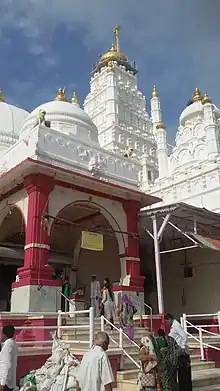
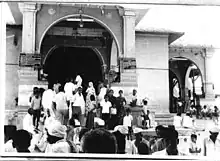
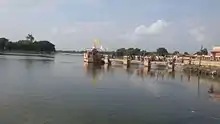
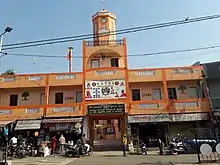
Demographics
As of 2001 India census,[6] Dakor had a population of 23,784. Males constitute 53% of the population and females 47%. Dakor has an average literacy rate of 76%, higher than the national average of 59.5%: male literacy is 82% and, female literacy is 69%. In Dakor, 10% of the population is under 6 years of age.
References
- ↑ Mallison, Françoise (2019). Religious Culture of Gujarat: Twelfth to Twentieth Century. Primus Books. p. 220.
- 1 2 3 Mallison 2019, p. 219-221.
- ↑ Majmudar 1960, p. 203.
- 1 2 3 4 Majmudar, M.R. (1947). "Dwārkā Image of Raṇchhoḍjī and the temple at Ḍākore". Journal Of The University Of Bombay. 16: 57–91.
- ↑ Majmudar, M.R. (1960). Cultural History of Gujarat [From Early Times to Pre-British Period]. Popular Prakashan. p. 203.
- ↑ "Census of India 2001: Data from the 2001 Census, including cities, villages and towns (Provisional)". Census Commission of India. Archived from the original on 16 June 2004. Retrieved 1 November 2008.